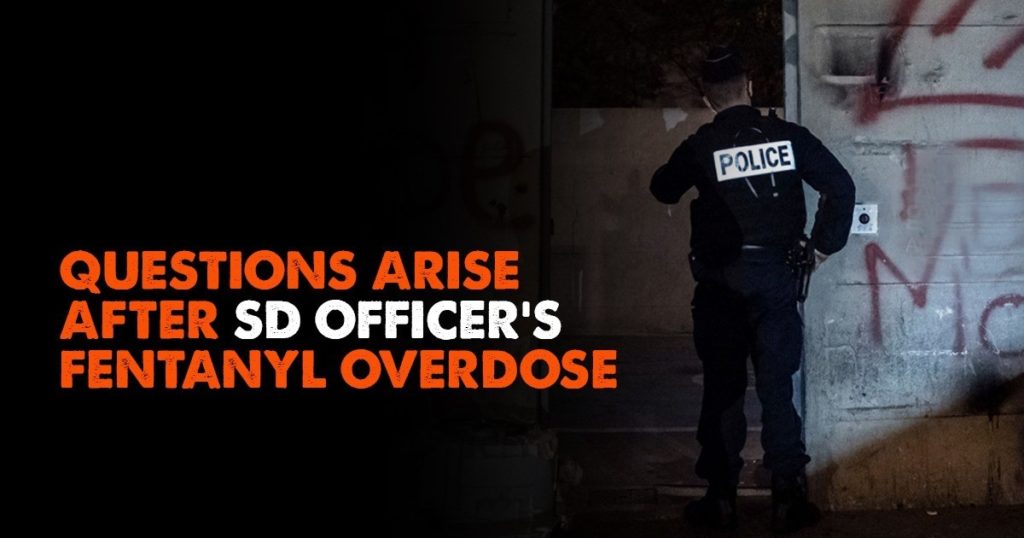In August, a video released by the San Diego Sheriff’s Department went viral. You can find it by searching terms like “county sheriff fentanyl overdose San Diego” and “county sheriff fentanyl overdose San Diego.”
In the viral video, Deputy David Faiivae collapses in a parking lot after handling a white powder. The Sheriff’s Department of San Diego County said Deputy Faiivae experienced a fentanyl overdose. Health professionals and addiction experts reporting on the story have mixed theories as to whether or not that’s the reality of what we saw in the body-worn camera footage.
While some aren’t sure if the deputy was experiencing an opioid overdose because of exposure to fentanyl or something else, the big takeaway for all of us is how prevalent and potent fentanyl is.
In the feature video below, The Mental Health Center of San Diego appears on Fox News to share some of our expertise and knowledge regarding the rise of fentanyl overdoses; watch the video and read on to learn more about the situation in development.
Did a San Diego Deputy Have a Fentanyl Overdose on July 3rd?
The body camera video of Deputy Faiivae was from July 3, 2021, according to reports from the San Diego Union-Tribune and other media outlets. Faiivae, in body camera footage, handles a bag of white powder, and shortly after, he collapses. The Sheriff’s Department released a video recently to highlight the dangers of fentanyl. Corporal Scott Crane described Faiivae as OD’ing the entire way to the hospital following the skin contact and potential respiratory contact with fentanyl.
Recently released documents in the County Sheriff fentanyl overdose in San Diego show that Deputy Faiivae was handling substances testing positive for fentanyl and methamphetamine. However, those reports don’t indicate whether Faiivae experienced a fentanyl overdose. The deputy’s injuries are listed as possible internal injury, other significant injuries, and unconsciousness. There isn’t a toxicology report available for Deputy Faiivae.
In an interview following the video release, Dr. Scott Krakower, a psychiatrist at Zucker Hillside Hospital in Queens, said that it doesn’t take much fentanyl to do serious harm. Not knowing the potency of fentanyl when you’re handling it could lead to overdose symptoms.
However, other medical experts have been more skeptical. Dr. Ryan Marino, medical director of toxicology and addiction medicine at University Hospitals in Cleveland, said you couldn’t overdose from secondhand contact. Dr. Marino, in his interview, said the only way to overdose is from injecting, snorting, or ingesting a substance in some other form.
- While the reports available currently don’t state how Deputy Faiivae may have gotten fentanyl into his system, we do see a chain of events that could have led to him accidentally ingesting it.
- According to a statement from Deputy Faiivae, he partially opened one bag. Some particles of the fentanyl powder it contained spilled onto the surface of his vehicle.
- He then swept the particles of the powdery substance and the other bags into an evidence bag.
- The results of the substances came back positive for fentanyl.
- Corporal Crane, a field training officer, told Deputy Faiivae to double-bag the items for safety.
- At that point, Deputy Faiivae reached down to get a second bag, and when he did, he placed his face around six inches from where the testing of the fentanyl powder was going on.
- Then, he started to feel lightheaded and fell following potential fentanyl exposure.
After falling, Deputy Faiivae was given four doses of Narcan in nasal spray form. Narcan is a drug that reverses the effects of opioids and an overdose.
Deputy Faiivae was then taken to a hospital and later recovered, according to the Sheriff’s Department.
Some medical professionals who have weighed in on the video say that rather than an overdose, Faiivae could have experienced a panic attack when he realized he was handling such a dangerous drug. According to the Sheriff’s Department, the video was released as a public safety video and public service announcement about fentanyl-related overdoses.
Mental Health Center of San Diego
The Potency of Fentanyl
Addiction experts say it’s certainly possible that Deputy Faiivae did experience an overdose even with his limited contact with fentanyl. Fentanyl is a synthetic opioid and a highly deadly drug. Like morphine, but 50 to 100 times stronger, the synthetic opioid fentanyl is a prescription drug. Fentanyl is also an illicit drug made in black market facilities.
In medical environments, available brand names include Actiq, Duragesic, and Sublimaze. Fentanyl is typically reserved medically to treat only very severe pain.
Synthetic opioids like deadly fentanyl are now the most commonly involved drugs in overdose deaths in the United States. In 2017, according to the National Institute on Drug Abuse, 59% of opioid-related deaths involved fentanyl. Only 14.3% of drug overdose deaths involved fentanyl in 2010, representing a considerable increase in overdose deaths attributed to this particular substance.
As a prescription, fentanyl is given as a shot. Fentanyl also comes as a patch you place on the skin or a tablet you suck like a cough drop.
The fentanyl we hear increasingly about as being involved in overdoses comes from illegal labs. Synthetic fentanyl is sold as a powder or made into counterfeit pills that may look like other prescription opioid drugs.
Drug dealers increasingly combine fentanyl with other drugs, which we’ve seen in several high-profile medical stories lately, leading to deaths. Drug dealers put fentanyl in methamphetamine, heroin, cocaine, and MDMA.
The reason is that it creates a high with very little, so it’s cheaper.
When people don’t realize they’re taking fentanyl, they are much more likely to overdose, making it an invisible killer in many cases. A lethal dose can be extremely tiny. Even just a few grains of fentanyl could be deadly for some.
Mental Health Center of San Diego
Fentanyl’s Effects on the Brain
Fentanyl generally acts like heroin, morphine, oxycodone, and other opioids. The fentanyl will bind to your opioid receptors. Opioid receptors are throughout the body, particularly in the brain’s parts, responsible for controlling emotions and pain.
Fentanyl and other opioids are highly addictive, leading to the potential for a substance use disorder.
The effects of fentanyl can include:
- Happiness or euphoria
- Drowsiness
- Nausea
- Confusion
- Sedation
- Constipation
- Problems breathing or respiratory depression
- Loss of consciousness
What Happens If You Overdose on Fentanyl?
As the fentanyl overdose in San Diego shows, even a tiny amount of this substance can be incredibly harmful. When you overdose on fentanyl, your breathing can slow down or stop altogether. Then, less oxygen can reach your brain, known as hypoxia. Hypoxia can lead to brain damage, a coma, or death.
Signs of a fentanyl overdose include:
- Drowsiness
- Dizziness
- Limp body
- Nausea
- Vomiting
- Low blood pressure
- Changes in the size of the pupils
- Cold, clammy skin
- Blue lips and fingernails
- Slow or stopped breathing
- Low heart rate
- Reduced consciousness or loss of consciousness
Recently, the Centers for Disease Control and Prevention conducted a study to understand more about the characteristics of a fentanyl overdose. The researchers in the study conducted interviews of more than 60 people who had first-hand experience with fentanyl overdose. All had used fentanyl in the past year and either witnessed or survived an overdose in the past six months.
One of the most universally described features of a fentanyl overdose was the rapid onset. Around 75% of respondents said the symptoms of an overdose occurred from seconds to minutes for them. That would line up with the timing of the County Sheriff’s fentanyl overdose San Diego video. Many said they didn’t have time to take the needle out of their arm before hitting the ground.
Other responses common in the study were foaming at the mouth, gurgling sounds, stiffening of the body, and confusion or strange behavior.
Mental Health Center of San Diego
The Scope of Fentanyl Abuse
We think it’s vital that people learn more about fentanyl and its devastating and even deadly effects. Fentanyl is one of the most significant contributors to the opioid epidemic in its current form. In 2018, the National Survey on Drug Use and Health showed 269,000 people misusing prescription fentanyl 2018.
As we learn more, the hope is to prevent these needless deaths from continuing to occur. If you, or someone you love, struggles with anxiety or addiction, the Mental Health Center of San Diego can help; call (858) 258-9883 to learn more.









